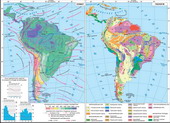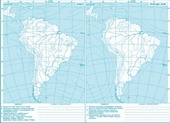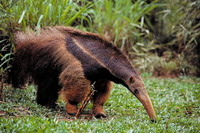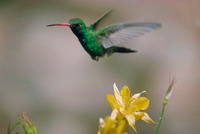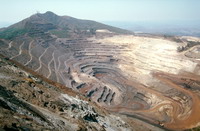Climate
determines the geographical position of the continent receiving large number of solar radiation throughout the year. South America - nayvolohishyy continent of the globe. Pasatna circulation and influence of warm currents of the Guiana and Brazilian - the basic premises that the average annual rainfall on the continent about twice the size than any other continent. However, the cold Peruvian current and the area of high atmospheric pressure of doing the west coast (Atacama Desert) most droughty area, not only in South America, but throughout the world. The impact of climate on the mainland is a relief. Andes - the longest mountain system on Earth - a barrier to penetration of dry cool Pacific air masses. It was formed alpine type climate. The plains in the east, by contrast, allow almost unhindered from the Atlantic to penetrate the warm and moist air masses deep into the mainland.
to constantly hot and humid equatorial zone accounts for the western part of the Amazon lowlands and the north-west Pacific coast. The climate of the equatorial belt of North America shaped by moist Atlantic air masses and high temperatures throughout the year.
For subekvatorialnyh zones characterized by hot humid summers, dry winters and hot minor differences summer and winter temperatures (Orinokska lowlands and the Guiana Plateau , eastern and southern lowlands of the Amazon, some Brazilian Plateau).
south-eastern part of the Brazilian plateau, the northern part of La - Plata are in lowland tropical Belt and are characterized more contrasting seasons with higher temperatures and drops in rainfall in coastal and inland areas. Rain falls mostly in summer, but considerably less than in subekvatorialnyh zones.
subtropical zone characterized by significant differences of its various parts. From warm with a uniform damp in the east and dry continental in the hinterland to Mediterranean on the Pacific coast climate with dry summers and wet winters.
Moderate climatic zone of the continent shaped by western transfer of air masses and is characterized by clearly pronounced seasons. Significant moisture (up to 3 000 mm per year) formed the western part of the zone is temperate maritime type climate with little temperature fluctuation throughout the year and lots of rain. East zone is characterized by sharp fluctuations in temperature and little rainfall ( temperate continental type climate).
Natural Area
Wet equatorial forests in South America called Selva . This nature reserve was formed on Amazon lowlands, adjacent slopes of the Andes, and in the northern Pacific coast, and covers a larger area than similar forests in Africa. Here, the red-yellow soils feralitnyh thousand species of plants grow. Trees make up to twelve storeys, the largest of which reaches 80 m in height and 4 m in diameter ( Ceiba ). Lower tier - real impenetrable thickets ( rubber tree, cocoa, mellon tree ferns ). Plants growing in rivers Victoria reggae - water lilies with leaves to 2 m . The same rich and fauna ( monkey, sloth, jaguar, anaconda , etc.). Particular attention should hummingbird - the smallest bird on earth and piranha - only bloodthirsty fish. The local forests teeming with insects and spiders .
Zone shroud and woodlands of northern and southern mainland differ. And Savannah woodlands in the Guiana Plateau and Lowland Orinokskoyi resemble African savanna with palm instead baobab . Savannah in the south of mainland posushlyvishi because trees here - a rarity, and the red and reddish-brown soils dominate shrubs, treelike cacti, and trees with barrel barrel. Peculiar and fauna here: unlike the African savannah, there was ungulates. tapir, bakers, cougar, murashkoyid with lots of ants and termites - typical inhabitants of these places.
savannas to the south are moving into the area of subtropical grassy steppes ( pampa) . Typical for these places is a great difference climate in sediments: from mild with a uniform moistening of the east it changes to more arid with significant variations in temperature in the south and west zones. Significant damage to the local natural vegetation causing considerable plowing and unsystematic grazing cattle. The animals of this zone occur ostrich rhea, pampasnyy deer, llama, many different places in these rodents .
In the southern part of the mainland, called Patagonia, area formed semi desert - unique in the world where they enter the ocean coastline within the temperate zone. With the small number of rainfall is very poor living world: the sirozemnyh and brown soils grow cereals, cacti and podushkopodibni Trees . Fauna is represented mainly reptiles and rodents, though there cougar, llama, ostrich rhea . Coastal desert and semi-narrow stretch and on the west coast of the mainland. Driest part of the natural area - Atacama Desert - the most droughty location on the planet. Prevailing air masses, and chilled air flow Peruvian rain clouds do not form. So it happens that the rain is falling here in 10-20 years.
With high altitude in the Andes developed altitude explain : from humid equatorial forests ( Gilea ) at the foot of the mountains in the equatorial mountain belt to meadows at high altitudes. Above 5000 m the snow never melts, turning into ice.
 English
English
